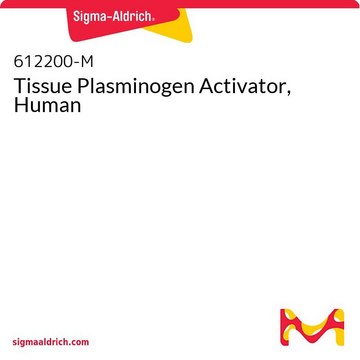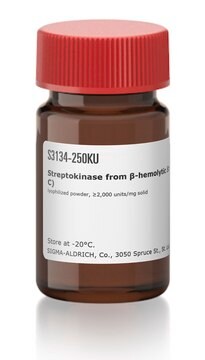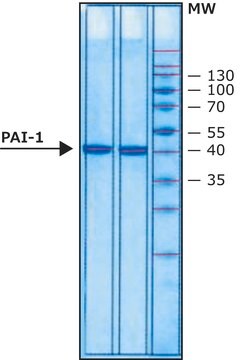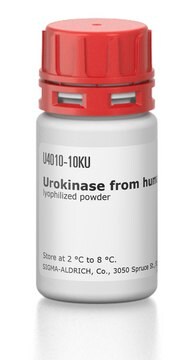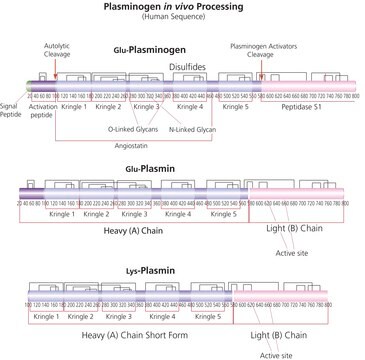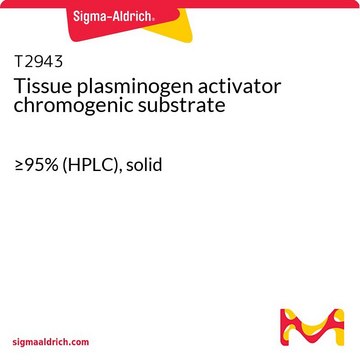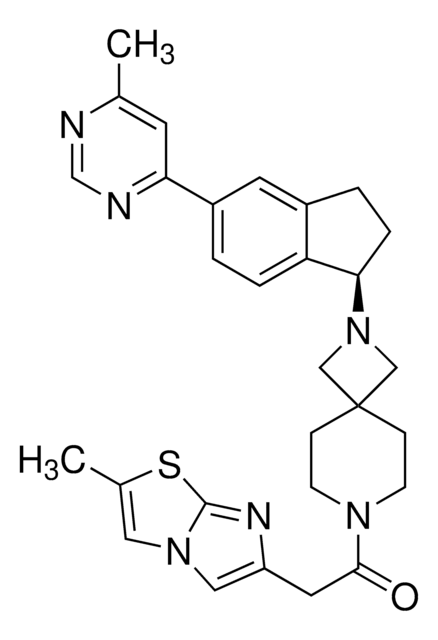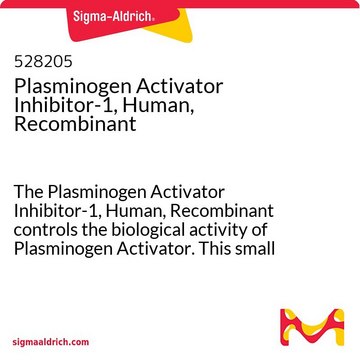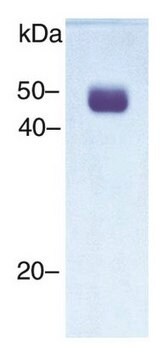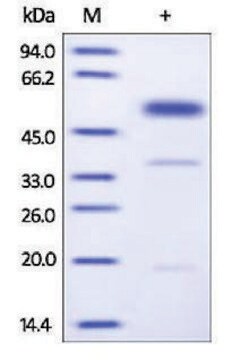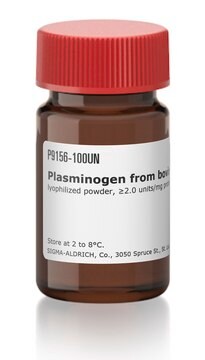T0831
Tissue plasminogen activator human
Synonyme(s) :
tPA
Se connecterpour consulter vos tarifs contractuels et ceux de votre entreprise/organisme
About This Item
Numéro MDL:
Code UNSPSC :
12352204
Nomenclature NACRES :
NA.54
Produits recommandés
Forme
lyophilized powder
Niveau de qualité
Activité spécifique
≥300 KU/mg protein
Poids mol.
~70 kDa
Impuretés
HIV, HCV, and HBsAg, tested negative
Numéro d'accès UniProt
Conditions d'expédition
wet ice
Température de stockage
−20°C
Informations sur le gène
human ... PLAT(5327)
Vous recherchez des produits similaires ? Visite Guide de comparaison des produits
Description générale
Tissue plasminogen activator (tPA) is a protease of the S1 family (trypsin family) and is found in a wide variety of mammalian tissues, especially endothelial cells. tPA is secreted as a single chain precursor, which is cleaved to a two-chain form by plasmin. Supplied in the single chain form with a molecular weight of ~70 kDa. The Tissue Plasminogen Activator (tPA) gene is mapped to human chromosome 8p11.21 and encodes a protease of 69 kDa majorly containing serine amino acid residue. It is predominantly expressed in endothelial cells.
Application
Tissue plasminogen activator has been used in a study to assess treatment risks of intracranial hemorrhage among patients with acute ischemic stroke. Tissue plasminogen activator has also been used in a study to investigate the successful treatment of early thrombosis of HeartWare left ventricular assist devices with intraventricular thrombolytics. Human tissue plasminogen activator has been used to study the effect of tyrosinase-related protein 2 (TRP-2) expression on melanin production in sheep.
Actions biochimiques/physiologiques
tPA is a potent activator of fibrinolysis and converts plasminogen into plasmin and also initiates cell signaling. The plasminogen activation system may also be associated with degradation of amyloid fibrils. It is also known to mediate inflammatory and extracellular matrix remodeling processes and is predicted to participate in disease progression of intracranial aneurysm indicating brain vascular malformations. Upregulation of the gene is observed in aortic aneurysms.
Forme physique
Lyophilized powder, from 100 mM PBS (pH 7.4), 3.5 mg/mL L-arginine, and 0.001% Tween® 80
Notes préparatoires
Reconstitute with dH2O to a final concentration of 1 mg/mL (e.g. 100 μg should be reconstituted in 100 μL).
Informations légales
TWEEN is a registered trademark of Croda International PLC
Mention d'avertissement
Warning
Mentions de danger
Conseils de prudence
Classification des risques
Eye Irrit. 2 - Skin Irrit. 2 - STOT SE 3
Organes cibles
Respiratory system
Code de la classe de stockage
11 - Combustible Solids
Classe de danger pour l'eau (WGK)
WGK 3
Point d'éclair (°F)
Not applicable
Point d'éclair (°C)
Not applicable
Faites votre choix parmi les versions les plus récentes :
Déjà en possession de ce produit ?
Retrouvez la documentation relative aux produits que vous avez récemment achetés dans la Bibliothèque de documents.
Les clients ont également consulté
Converting Tissue Type Plasminogen Activator into a Zymogen IMPORTANT ROLE OF Lys156.
Tachias K and Madison E L
The Journal of Biological Chemistry, 272(1), 28-31 (1997)
Design, synthesis, and characterization of urokinase plasminogen-activator-sensitive near-infrared reporter.
Law B, et al.
Chemistry & Biology, 11(1), 99-106 (2004)
Successful treatment of early thrombosis of HeartWare left ventricular assist device with intraventricular thrombolytics.
Kamouh A, et al.
The Annals of Thoracic Surgery, 94(1), 281-283 (2012)
Differential expression assay of chromosome arm 8p genes identifies Frizzled-related (FRP1/FRZB) and Fibroblast Growth Factor Receptor 1 (FGFR1) as candidate breast cancer genes.
Ugolini F, et al.
Oncogene, 18(10), 1903-1903 (1999)
Amorphous protein aggregates stimulate plasminogen activation, leading to release of cytotoxic fragments that are clients for extracellular chaperones.
Constantinescu P, et al.
The Journal of Biological Chemistry (2017)
Notre équipe de scientifiques dispose d'une expérience dans tous les secteurs de la recherche, notamment en sciences de la vie, science des matériaux, synthèse chimique, chromatographie, analyse et dans de nombreux autres domaines..
Contacter notre Service technique